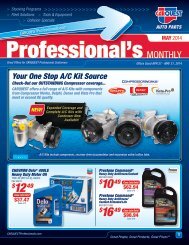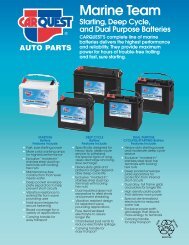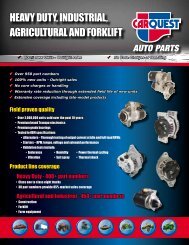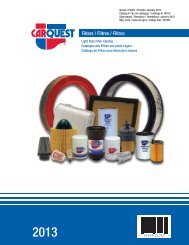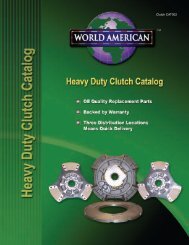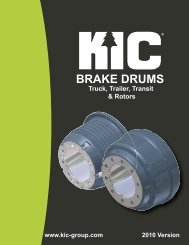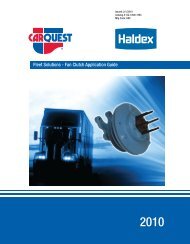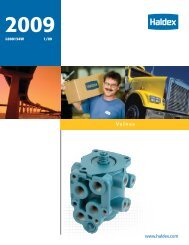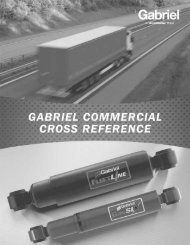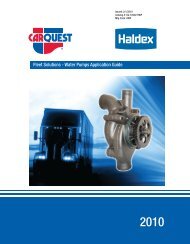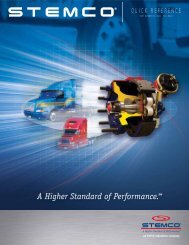Steering Gears Application Guide - CARQUEST Auto Parts
Steering Gears Application Guide - CARQUEST Auto Parts
Steering Gears Application Guide - CARQUEST Auto Parts
- No tags were found...
You also want an ePaper? Increase the reach of your titles
YUMPU automatically turns print PDFs into web optimized ePapers that Google loves.
16−POWER STEERING GEARSFinal AdjustmentBLEEDING AIR FROM SYSTEMThe steering gear by design is self bleeding; however, in some installations where the gear is positioned at an odd angle or where the piston doesnot make a full stroke in the cylinder bore air can be trapped in the steering gear. To avoid this possibility the air should be bled from the systemanytime the oil has been changed or the steering system is repaired.After reinstalling the steering gear on the vehicle but prior to connecting the drag link to the pitman arm, bleed the air from the steering system in thefollowing manner:1. Fill pump reservoir with recommended oil. It will be necessary to continue fillingafter starting the engine and during the bleeding operation until correct oil level ismaintained.2. Set parking brake or block wheels. Start engine and allow it to operate at fast idlespeed.3. With engine running, turn steering wheel from left to right and return making threecomplete cycles to remove all air from the steering system.4. Stop engine. Reconnect the drag link.Following these procedures will ensure that the piston bottoms in both directions of steer,opens the relief valve in the piston, and allows the air to escape to the reservoir and into theatmosphere. (See Fig. A) Check and adjust the relief valve plungers as required.ADJUSTING RELIEF VALVE PLUNGERSThe relief valve plunger adjustment is provided to automatically reduce the steering pressure when the road wheels have reached their limits of turn.This keeps the supply pump from operating at maximum relief pressure when the road wheels are at their steering limits. System temperatures aretherefore reduced and high stress loads on the mechanical components of the steering system are relieved.High−pressure oil at either end of the piston will push the relief ball valve off its seat and fillthe relief passage with oil at high pressure. At the opposite end of this passage the relief ballvalve is held against its seat and holds the high pressure in the relief passage. As the pistonmoves close to its limits of stroke, the adjustable relief plungers push the relief ball valve offits seat and the pressure is relieved. The distance the piston can move is dependent uponthe total front axle/steering system geometry and tire size. the relief valve plungers areadjustable to allow for variations or changes in these areas. Adjust the relief valve plungersas follows:1. Start the engine and allow it to operate at idle speed.2. With full weight of the vehicle on all wheels, turn the steering wheel in onedirection until a high−pressure hiss is heard or the axle stops contact.3. Turn the relief valve plunger in or out until the high−pressure hiss is heard whenthere is 1/8 to 3/16 inch clearance between the axle stops. (See Fig. B)4. Repeat this procedure for the opposite direction of steer, and adjust the reliefvalve plunger on the opposite end of the steering gear.Turning the plungers in will increase the space between the axle stops. Turning the plungers out will decrease the clearance between the stops. Donot turn the slotted plungers out beyond flush with the plunger boss or a leak will occur. Axle stops should only be adjusted in accordance with thevehicle manufacturer's specifications.After relief valve plunger adjustment always check to ensure that the road wheels and tires have adequate clearance between suspension, brakeand frame components.16 − 38



